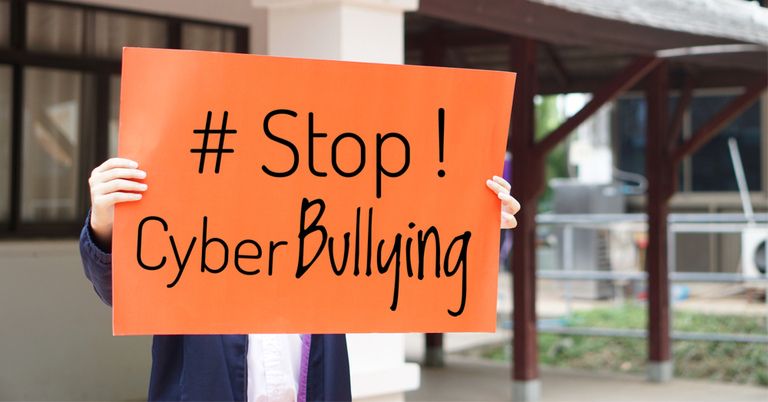Cyberbullying is a growing issue among teenagers today. It is a form of bullying that takes place online, through various forms of digital media such as social media, websites, and text messaging. With the widespread use of technology and social media, bullying has taken on a new form that can reach a larger audience and have even more devastating effects. It can cause serious emotional distress and can have a lasting impact on a teen’s mental health and well-being.

As parents, we should be aware that the effects of cyber bullying on teens can be severe and long-lasting, impacting their mental health, self-esteem, and relationships with others. In this article, we will explore the issue of cyberbullying and its impact on teenagers, as well as what can be done to prevent and address this growing problem.
Definition of cyber bullying
Cyber bullying is a form of bullying that uses electronic devices and the internet to harass, threaten, or humiliate someone. It has become a widespread problem in recent years, with the rise of technology and social media usage among young people.

Cyberpsychology can take many different forms, including mean or threatening text messages, emails, and instant messages, as well as cyber victimization by spreading rumors and gossip through social media platforms. It can also involve the posting of embarrassing photos or videos, or creating fake profiles to harass someone.
One of the key characteristics of cyber bullying is its ability to reach a large audience quickly and easily. Unlike traditional forms of bullying, which may have been limited to a small group of people, cyber bullying can quickly spread to hundreds or even thousands of people through social media and other online networks.
What are the factors of cyberbullying?
Cyber bullying has become a major concern in recent years due to the increasing use of technology and social media. While there is no single cause of cyberbullying, there are several factors that can contribute to its occurrence. Understanding these factors can help individuals and communities take steps to prevent cyberbullying from happening and support those who have been affected.

1. Anonymity
One of the key factors contributing to cyberbullying is the anonymity provided by the internet. Individuals may feel emboldened to engage in bullying behavior when they believe they can do so without consequence. This anonymity can also make it easier for individuals to behave in ways they may not in person.
2. Reach
Another factor contributing to the prevalence of cyberbullying is its reach. The internet and social media allow individuals to share harmful messages and images with a large audience quickly and easily, amplifying the impact on the victim.
3. Lack of Consequences
Some individuals may engage in cyber bullying because they believe there will be no consequences for their actions. They may feel that they can get away with bullying behavior online, where they may not feel as confident bullying in person.
4. Immaturity
Young people are particularly vulnerable to the effects of cyberbullying, as they may lack the maturity and judgment to understand the consequences of their actions online. This can make them more likely to engage in bullying behavior.
5. Mental Health Issues
Some individuals who engage in cyberbullying may have underlying mental health issues, such as anger or depression. These individuals may use bullying behavior as a way to cope with their own feelings of insecurity or frustration.
6. Family or Peer Pressure
In some cases, individuals may engage in cyberbullying due to pressure from friends or family members. They may feel compelled to participate in bullying behavior in order to fit in with a certain group or to avoid being bullied themselves.
7. Past Experience with Bullying
Individuals who have been bullied in the past may be more likely to engage in cyberbullying themselves. This can create a vicious cycle where individuals who have been victims of bullying become bullies themselves.
8. Availability of Technology
The widespread availability of technology and social media has made cyberbullying a much more prevalent problem in recent years. The ease of access to these platforms has made it easier for individuals to engage in bullying behavior, regardless of their age or background.
Importance of discussing cyberbullying and its effects on teens
Cyberbullying is a serious issue that affects millions of teens today. Cyberbullying is the use of technology to harass, threaten, embarrass, or target another person. It can include sending, posting, or sharing negative, harmful, false, or mean content about someone else. Cyberbullying can occur through social media, texting, messaging apps, gaming, or in chat rooms.

Unlike traditional bullying, which may stop when the school day is over or when the bullies leave the area, cyber bullying can continue 24/7. The constant barrage of messages and posts can make the effects of cyber bullying even more traumatic for victims. Therefore, discussing cyberbullying and its effects on teens is an important part of helping them through a difficult situation. It can help teens to understand the severity of the problem and the lasting impact it can have on their mental health and overall wellbeing.
By discussing cyber bullying and its effects, parents can help prevent the behavior from happening in the first place. Teens are more likely to engage in bullying behavior if they don’t understand the harm it can cause. By talking about the issue, adults can help create a culture of respect and empathy online, making it less likely for bullying to occur. Besides, teens can understand that they are not alone and that there are people who care and can help them.
Teen cyber bullying statistics

Cyber bullying has become a major issue for teens in recent years, and the statistics paint a concerning picture of the prevalence and impact of this form of bullying. Here are some key statistics that highlight the issue of teen cyberbullying:
1. Prevalence
According to a survey conducted by the Cyberbullying Research Center, 34% of teens have experienced cyber bullying in some form. Meanwhile 46% teens in the U.S. report ever experiencing at least one of six cyberbullying behaviors according to Pew Research. This includes being bullied through texts, social media, or other online platforms.
2. Gender
Girls are more likely to experience cyber bullying than boys, with 39% of girls reporting being cyber bullied compared to 29% of boys.
3. Age
Teens aged 14-17 are most likely to experience cyber bullying, with the highest prevalence reported in 15-year-olds.
4. Social Media
Social media is the most common platform for cyber bullying, with 61% of teens reporting that they have been bullied on social media.
5. Mental Health
The effects of cyberbullying can be severe and long-lasting. A study by the Journal of Adolescent Health found that victims of cyber bullying are 2-9 times more likely to have depression, anxiety, and suicidal behaviors.
6. Bullying and School Performance
Cyber bullying can also impact a teen’s school performance. A study by the National Education Association found that students who experience bullying, including cyber bullying, are more likely to miss school, receive lower grades, and have lower educational aspirations.
7. Responses to Cyber Bullying
Only 1 in 10 teens who experience cyber bullying will tell a parent or trusted adult about the behavior, according to The New York Times. Many teens may feel ashamed or embarrassed to talk about their experiences, or they may fear retaliation from the bully.
Types of Cyber Bullying

Cyber bullying has become a widespread issue in recent years, with the rise of technology and social media making it easier for individuals to engage in bullying behavior online. While traditional bullying and cyberbullying share many similarities, there are several distinct forms of cyber bullying that pose unique challenges for victims and those trying to prevent and address this behavior. In this article, we will explore the different types of cyber bullying and the ways in which they can impact individuals, especially teens.
Harassment

Cyber harassment is a form of cyber bullying that involves the use of technology to threaten, intimidate, or harm another person. This type of emotional abuse is common in teens, who are more likely to experience cyber harassment due to their increased use of technology and social media. Here are some of the common methods used in cyber harassment and why this type of behavior is particularly harmful to teens.
1. Harassment through Social Media
Social media is the most common platform for cyber harassment, with bullies using platforms like Facebook, Twitter, and Instagram to spread rumors, harass, or threaten their victims. This type of harassment can be particularly harmful because it can reach a large audience and be seen by many people.
2. Exclusion through Online Gaming
Online gaming is another common platform for cyber harassment, with bullies using games to exclude, harass, or threaten their victims. This type of behavior can be particularly harmful because it can impact a teen’s ability to participate in a leisure activity that they enjoy.
3. Revenge Porn
Revenge porn is a form of cyber harassment that involves the distribution of sexually explicit images or videos without the consent of the victim. This type of behavior can be particularly harmful because it can damage a teen’s reputation and self-esteem, and the images or videos can be difficult or impossible to remove from the internet.
4. Stalking through GPS Tracking
GPS tracking is a form of cyber harassment that involves using technology to stalk or track a person’s movements. This type of behavior can be particularly harmful because it can make a person feel constantly monitored and threatened.
Flaming
Flaming often starts with a simple disagreement or argument, but it can quickly escalate into name-calling, personal attacks, and threats. The anonymity and distance of the internet can make it easier for individuals to engage in flaming behavior and to say things that they might not say in person.

Moreover, flaming can also escalate quickly online due to the speed and ease of communication. A single comment can quickly be followed by a flurry of responses, and the situation can quickly spiral out of control. This can make it difficult for individuals to intervene and stop the behavior before it becomes more severe.
The impact of flaming on a teen’s emotional well-being can be significant. It can cause feelings of shame, embarrassment, and low self-esteem. The constant barrage of negative comments can also lead to depression, anxiety, and even suicide. Additionally, the public nature of flaming can make it difficult for victims to escape the harassment, as the comments are visible to a large audience and can be difficult to remove from the internet.
Outing
Outing is a form of cyber bullying that involves the unauthorized sharing of private or personal information online. The perpetrator may share the information with the intent to humiliate or shame the victim, or to damage their reputation. This type of behavior can have severe consequences for a teen’s privacy and reputation, and it is often used as a form of cyber bullying to harm or embarrass the victim.

Outing can involve the sharing of personal information such as a person’s name, address, phone number, or other contact information. It can also involve the sharing of sensitive information such as a person’s sexual orientation, religion, or political beliefs. The sharing of this information can leave the victim vulnerable to harassment, stalking, or other forms of cyber bullying.
The consequences of outing for a teen’s privacy and reputation can be severe. The victim may experience feelings of shame, embarrassment, and low self-esteem. The unauthorized sharing of personal information can also damage a person’s reputation and make it difficult for them to trust others in the future. In some cases, outing can even result in physical harm, such as stalking or harassment.
Impersonation
Impersonation is a type of cyber bullying that involves pretending to be someone else online in order to deceive, harass, or intimidate another person. The impersonator may use the fake identities to bully or harass the victim, to spread false information about them, or to damage their reputation. The anonymity and distance of the internet can make it easier for individuals to engage in impersonation behavior and to harass or intimidate others without fear of immediate consequences.

Impersonation can involve creating fake social media profiles, email accounts, or other online identities that mimic or resemble the victim. This type of behavior can have a significant impact on a teen’s self-esteem and relationships, and it is often used to harass and intimidate teens online.
The impact of impersonation on a teen’s self-esteem and relationships can be severe. The victim may experience feelings of shame, embarrassment, and low self-esteem. The spread of false information or the harassment and bullying can also damage a person’s reputation and make it difficult for them to trust others in the future. In some cases, the victim may even feel physically threatened by the impersonator.
Cyberstalking
Cyberstalking is a form of online harassment that involves the use of technology to stalk, harass, intimidate, or threaten another person. It can take many forms, including repeated email or text messages, social media harassment, or the use of spyware or other tracking tools to monitor a person’s online activity.

Characteristics of cyberstalking include persistent and repetitive behavior, an intent to threaten or intimidate the victim, and the use of technology to carry out the behavior. In some cases, the cyberstalker may also engage in other forms of cyber bullying or harassment, such as impersonation or outing.
It is important for individuals, families, schools, and communities to be aware of the dangers of cyberstalking and to take steps to prevent and address this behavior. This can include promoting digital literacy and cyber safety, educating individuals about the risks of cyberstalking, and providing support and resources for those who have been affected.
What is the purpose of cyberbullying campaign?

Cyberbullying campaigns for teens are initiatives aimed at raising awareness and understanding about the issue of cyberbullying among young people. Cyberbullying campaigns for teens can take many forms, including school-based initiatives, social media campaigns, public service announcements, and community events. The purpose of these campaigns is to empower teens to take action against cyberbullying, both by preventing it from happening and by providing support to those who have been affected.
The main objectives of cyberbullying campaigns for teens include:
1. Educate Teens about Cyberbullying
Many campaigns aim to educate teens about what cyberbullying is and how it can impact them. This can help to raise awareness and prevent cyberbullying from happening in the first place.
2. Empower Teens to Stand Up Against Cyberbullying
Campaigns may also aim to empower teens to stand up against cyberbullying by promoting positive online behavior and providing resources and support to help individuals avoid engaging in harmful behavior.
3. Provide Support to Victims
Another important aspect of many cyberbullying campaigns is to provide support and resources to those who have been affected by cyberbullying. This can include resources for teens, as well as hotlines and counseling services.
4. Promote Digital Citizenship
Many campaigns also aim to promote digital citizenship, which involves responsible and respectful use of technology, and to help young people develop a positive online identity.
Effects of Cyber Bullying on Teens

Cyber bullying is a serious problem that is growing among teens and can have a significant impact on their lives. It is defined as the use of digital media to communicate aggressive, insulting or intimidating messages to another person. Cyber bullying can take many forms, from posting insulting comments online to sending threatening emails or texts. It can cause teens to experience feelings of fear, humiliation, depression, and even suicidal thoughts. Let us examine the effects of cyber bullying on teens and how it can be addressed.
Psychological effects

Cyberbullying can have a profound impact on a teen’s mental health and well-being, causing a range of psychosomatic disorders that can last long after the bullying has stopped. Some of the most common psychological effects of cyberbullying on teens include:
1. Low self-esteem
Teens who are victims of cyberbullying often experience a significant decline in their self-esteem, leading to feelings of shame, guilt, and worthlessness.
2. Depression
Cyberbullying has been linked to an increased risk of depression, which can cause symptoms such as sadness, hopelessness, and a loss of interest in activities that were once enjoyed.
3. Anxiety
Teens who are victims of cyberbullying may experience high levels of anxiety, including symptoms such as worry, nervousness, and irritability.
4. Stress
The constant barrage of negative comments and attacks that are characteristic of cyberbullying can cause significant stress, leading to physical symptoms such as headaches, fatigue, and sleeping problems.
5. Isolation
Cyberbullying can cause teens to feel isolated and alone, leading to a decline in social support and a lack of positive relationships.
6. Suicidal thoughts
In severe cases, cyberbullying can lead to feelings of hopelessness and desperation, resulting in thoughts of suicide.
The psychological effects of cyberbullying on teens can be long-lasting and can impact their mental health and well-being for years to come. It is important for parents, teachers, and other adults in the lives of teens to recognize the signs of cyberbullying and to provide support and resources to help teens who are affected.
Physical effects

Cyberbullying can have not only psychological effects on teens, but it can also have physical consequences that can last long after the bullying has stopped. Let us explain some of the most common physical effects of cyberbullying on teens in the following points:
1. Headaches
Teens who are victims of cyberbullying may experience frequent headaches due to the stress and anxiety associated with being bullied.
2. Sleep disturbances
Cyberbullying can cause somatic symptoms of difficulty sleeping, leading to fatigue, irritability, and a decline in academic performance.
3. Stomach problems
The stress and anxiety associated with cyberbullying can cause physical symptoms such as nausea, diarrhea, and other digestive problems.
4. Decreased immunity
Stress and anxiety can weaken the immune system, making teens more susceptible to illness and infection.
5. Cardiovascular issues
Chronic stress and anxiety can contribute to heart disease and other cardiovascular problems in the long term.
6. Substance abuse
Teens who are victims of cyberbullying may turn to drugs or alcohol as a means of coping, leading to substance abuse and addictions.
Social effects

Cyberbullying can have a profound impact on a teen’s social life and relationships, affecting not only their immediate peers but also their future prospects and personal growth. Some of the most common social effects of cyberbullying on teens include:
1. Isolation and loneliness
Teens who are victims of cyberbullying may feel isolated and disconnected from their peers, leading to feelings of loneliness and depression.
2. Decreased self-esteem
Cyberbullying can have a devastating effect on a teen’s self-esteem, leading to feelings of worthlessness and insecurity.
3. Loss of friendships
The negative impact of cyberbullying on a teen’s relationships can result in the loss of important friendships and social connections.
4. Difficulty trusting others
Teens who have been victims of cyberbullying may struggle to trust others, leading to difficulty forming new relationships and building a support network.
5. Fear of future relationships
Cyberbullying can have long-lasting effects on a teen’s future relationships, as they may be afraid of being hurt or bullied again.
6. Difficulty in school
Teens who are victims of cyberbullying may struggle in school, as the stress and anxiety associated with bullying can affect their academic performance.
Educational effects

Cyberbullying can have a significant impact on a teen’s education, affecting their academic performance and their future prospects. Here are some of the most common educational effects of cyberbullying on teens:
1. Decreased academic performance
Teens who are victims of cyberbullying may struggle to concentrate in school, leading to decreased academic performance and grades.
2. Increased absenteeism
The stress and anxiety associated with cyberbullying can cause teens to miss school, leading to increased absenteeism and decreased engagement with their education.
3. Difficulty with online learning
With the increased reliance on technology in education, cyberbullying can become a major obstacle for teens trying to learn and engage with online resources.
4. Decreased motivation
The emotional toll of cyberbullying can cause teens to lose motivation and interest in their education, leading to decreased engagement and effort.
5. Decreased confidence in future goals
The negative impact of cyberbullying on a teen’s self-esteem and relationships can lead to decreased confidence in their future goals and aspirations.
Preventing Cyber Bullying

Cyberbullying can be detrimental to the health and wellbeing of its victims, resulting in depression and anxiety, even suicide in extreme cases. As such, it is important to take steps to prevent cyberbullying from occurring. This article will discuss various methods of preventing cyberbullying, with a particular focus on educating children and teens, monitoring online activity, and developing effective response strategies.
Awareness and education for teens
The prevention of cyberbullying is a complex challenge that requires a collaborative effort from technology companies, schools, organizations, and individuals. Technology companies play a crucial role in preventing cyberbullying by designing their products and services with bullying prevention in mind. This can include building in internet safety features and reporting mechanisms, providing education and resources for users, and working with law enforcement to hold bullies accountable.

Schools and organizations also have a critical role to play in preventing cyberbullying. By providing resources and support for victims, such as counseling services and educational resources, and promoting a positive school culture that values respect and inclusion, they can help to create a safe and supportive environment for all students.
It is also important for individuals, especially parents and caregivers, to educate themselves about cyberbullying and to talk to their children about responsible digital citizenship and how to recognize and respond to cyberbullying. By working together and taking proactive steps to educate and empower young adults about cyberbullying, we can help to prevent its harmful effects and create a safer and more respectful digital community for all.
Parental involvement and monitoring
One of the most important steps parents can take is to encourage open communication with their children about online safety. By fostering a safe and trusting environment, children are more likely to feel comfortable sharing their experiences and asking for help if they need it.

In addition to encouraging open communication, parents can also take steps to monitor their children’s online activities, such as setting limits on screen time, checking their children’s social media accounts and online forums, and talking to them about responsible digital behavior.
If a teen is a victim of cyberbullying, it is important for parents to provide support and help them feel heard. This may include listening to their experiences, seeking help from a trusted adult or counselor, and, if necessary, reporting the cybercrime to law enforcement.
Collaboration between schools, families, and communities
Cyber bullying is a growing concern for communities, families, and schools. Schools play a crucial role in addressing cyber bullying. They can provide education on safe and responsible digital behavior, as well as implement policies and procedures to address and respond to incidents of cyber bullying. Schools can also provide support to students who are victims of cyberbullying, such as connecting them with counseling services or involving law enforcement if necessary.

Families can also play a key role in preventing and addressing cyber bullying. Parents can educate themselves and their children about cyber bullying, encourage open communication, and monitor their children’s online activities. By working together with schools, families can help to create a safe and supportive environment for children and teens.
Community organizations can also help raise awareness and provide support for victims of cyber bullying. This can include hosting workshops and events to educate the public about cyber bullying, as well as providing resources and support for victims and their families. Besides, community organizations can also partner with schools and families to promote a coordinated and consistent approach to cyber bullying prevention and response.
How to recognize cyber bullying in teens
One common sign of cyber bullying is a sudden change in a teen’s behavior or mood. This can include withdrawal from social activities, low self-esteem, insecurities, and depression. Additionally, a teen who is being cyber bullied may also experience physical symptoms such as headaches, stomachaches, or difficulty sleeping.

Another sign of cyber bullying is the frequent use of electronic devices, especially outside of normal hours. Teens who are being bullied online may feel the need to constantly check their phone or computer for messages or updates from the person who is harassing them. This can lead to changes in sleep patterns, decreased physical activity, and a poor school performance.
Another red flag is a decrease in the frequency and quality of online communication with friends and family. Teens who are being bullied online may become isolated and may avoid communicating with others, even those they trust and care about. If a teen is experiencing any of these symptoms, you should take their concerns seriously and provide support.
Importance of addressing cyber bullying
Cyber bullying can have a significant impact on a teen’s mental, emotional, and physical well-being. It can cause feelings of anxiety, depression, and low self-esteem, as well as physical symptoms such as headaches, sleep problems, and decreased appetite. It can also interfere with a teen’s social life, causing them to withdraw from friends and activities and damaging their relationships. Additionally, cyber bullying can affect a teen’s educational performance, leading to decreased focus, lower grades, and decreased motivation.

For these reasons, it is important to address cyberbullying and take steps to prevent it from occurring. By educating young people about the dangers of cyberbullying and providing them with the tools and support they need to respond to it, we can help to reduce its impact and protect the well-being of our youth.
Parents, teachers, community organizations, and technology companies all have a role to play in addressing cyber bullying. Through open communication, collaboration, and a commitment to the well-being of our youth, we can work together to prevent cyber bullying and ensure that our young people grow up in a safe and supportive online environment.
Supporting victims of cyber bullying among teens
One of the first steps in supporting a victim of cyber bullying is to listen to them and provide a safe and supportive environment in which they can talk about their experiences. This may involve being patient, non-judgmental, and offering words of encouragement and support. Ask them to meet a counselor or therapist who can help them work through their feelings and develop coping strategies.You can also encourage them to engage in self-care activities, such as exercise, meditation, or spending time with supportive friends and family members.

Moreover, you should also help the victim to take practical steps to address cyber bullying and reduce its impact. This may involve reporting the bullying to school or law enforcement officials, blocking the bully on social media, or taking other steps to reduce their exposure to the abuse. By empowering them with the knowledge and resources they need to address the issue, we can help to reduce its impact and support them as they work towards recovery.
Strategies for combating cyber bullying in schools

Cyber bullying is a growing problem that is affecting more and more young people every day. It is crucial for schools to take a proactive approach to combat cyber bullying and support its victims. There are a variety of strategies that schools can implement to address cyber bullying. These include:
1. Education and Awareness
Educating students, teachers, and parents about the dangers of cyber bullying and how to recognize it is a key component of preventing it. Schools can organize workshops, assemblies, and other events to raise awareness and provide information on how to stay safe online.
2. Online Safety Policies
Schools should have clear and comprehensive cyber safety policies in place that outline what is considered cyber bullying and the consequences for those who engage in it. These policies should also provide guidance on how to report incidents and what support is available for victims.
3. Active Monitoring
Regular monitoring of school-provided technology and social media platforms can help identify instances of cyber bullying and take prompt action to address them.
4. Support for Victims
Providing support for victims of cyber bullying is critical to helping them recover from the experience. This may include counseling, peer support groups, and other resources to help them heal and regain their confidence.
5. Collaboration with Law Enforcement
In cases of severe cyber bullying, it may be necessary to involve law enforcement. Schools should have a clear protocol in place for reporting incidents to the appropriate authorities and working with them to address the problem.
6. Encouraging Bystander Intervention
Encouraging students to intervene when they witness instances of cyber bullying can help stop the behavior before it escalates. Schools can promote bystander intervention by creating a culture of respect and encouraging students to speak up when they see something that is not right.
Educating teens about cyber bullying and digital citizenship

Digital citizenship is a term used to describe the responsible use of technology and the internet. This includes being aware of the impact that our online behavior can have on others, as well as respecting privacy, security, and intellectual property. When it comes to preventing cyber bullying, digital citizenship is a critical component. There are several strategies that schools, families, and communities can use to educate teens about cyber bullying and digital citizenship. For example:
1. Provide informational resources
Teens need to be aware of what cyber bullying is and what the consequences can be. This can be achieved by providing them with informational resources, such as brochures, posters, and videos.
2. Foster open communication
Encourage teens to talk to their parents and teachers about their online experiences. This can help to prevent bullying before it starts and provide support to victims.
3. Implement school-wide policies
Schools should have policies in place that address cyber bullying and provide clear guidelines for students and staff. This will help to create a safe and respectful environment for everyone.
4. Offer digital citizenship education
Many schools now offer digital citizenship education as part of their regular curriculum. This can include lessons on internet safety, digital ethics, and responsible use of technology.
5. Engage the community
Communities can play an important role in addressing cyber bullying. For example, local organizations can host events and workshops that raise awareness and provide support to victims.
Recap of Key Points
- Cyberbullying is a serious problem that affects teenagers in the digital age. It refers to the use of technology, such as the internet, social media, and mobile phones, to harass, humiliate, or threaten someone. The effects of cyberbullying on teens can be severe, including psychological, physical, social, and educational consequences.
- Psychologically, cyberbullying can lead to low self-esteem, anxiety, depression, and even thoughts of suicide. Physically, it can cause stress, sleep problems, and other health issues. Socially, it can lead to isolation, rejection, and a loss of trust in others. Educationally, it can affect school performance, attendance, and participation.
- Strategies for combating cyberbullying include educating teens about digital citizenship, providing support to victims, and implementing anti-bullying policies in schools. It is also important to work together as a community to raise awareness of the issue and to promote a culture of kindness and respect online. By working together, we can help reduce the prevalence of cyberbullying and create a safer, more supportive online environment for teens.
Final Thought
In conclusion, cyber bullying is a serious issue that can have devastating effects on teens. It is important for schools, families, and communities to come together to address cyber bullying and provide support for victims. Educating young people about cyber bullying and digital citizenship, monitoring their online activities, and providing open communication can help prevent cyber bullying and support those who may fall victim to it. Hopefully, we can create a safer and more supportive online environment for our youth.
Latest Post:
- Smart Passive Income Ideas for Teens to Boost Your Monthly Allowance!
- These 25 Fullmetal Alchemist Tattoo Ideas Will Inspire You!
- Why Teenage Pregnancy is a Problem? Answers and Solutions
- 26 Must-Have Mortal Kombat Accessories to Finish Your Collection!
- An Expert Guide To Promoting Healthy Social Media Use Among Teenagers
FAQ (Frequently Asked Question)
What is the impact of cyberbullying on adolescent health?
Cyberbullying can have a significant impact on the health of adolescents. The emotional and psychological toll of being a victim of cyberbullying can lead to depression, anxiety, and low self-esteem. It can also lead to social isolation, feelings of hopelessness, and even thoughts of suicide. Besides, sleep disturbances, headaches, and stomach problems can result from the stress and anxiety caused by cyberbullying.
Why is anxiety the effect of cyberbullying?
Cyberbullying often occurs 24/7, as the internet is available all the time, making it difficult for teens to escape the constant harassment and abuse. This constant exposure to negativity and stress can cause significant anxiety and stress in teens. Additionally, the anonymity and distance provided by the internet can make it easier for bullies to engage in abusive behavior, and the victim may feel that they have no escape. This can lead to feelings of helplessness, powerlessness, and anxiety.
What is the conclusion of cyberbullying?
The conclusion of cyberbullying is that it is a serious issue that has negative and far-reaching effects on the health, well-being, and future prospects of adolescents. It is important for individuals, families, schools, and communities to take a proactive approach to preventing and addressing cyberbullying. This includes educating young people about responsible digital citizenship, monitoring their online activities, and providing support for those who have been victims of cyberbullying.
Why do we need to research cyberbullying?
Researching cyberbullying is important to understand the scope and nature of the problem. Research provides insight into the prevalence, patterns, and causes of cyberbullying, which is essential for developing effective prevention and intervention strategies. Moreover, research helps to identify the populations most vulnerable to cyberbullying, including gender, age, and cultural differences. This information can be used to develop targeted interventions to protect these groups.
- What to say to a daughter with a broken heart: Effective ways to console and support her! - October 16, 2023
- Essentials Know-How on Protecting teen privacy on social media - October 10, 2023
- The most challenging things about being 18 - October 5, 2023
